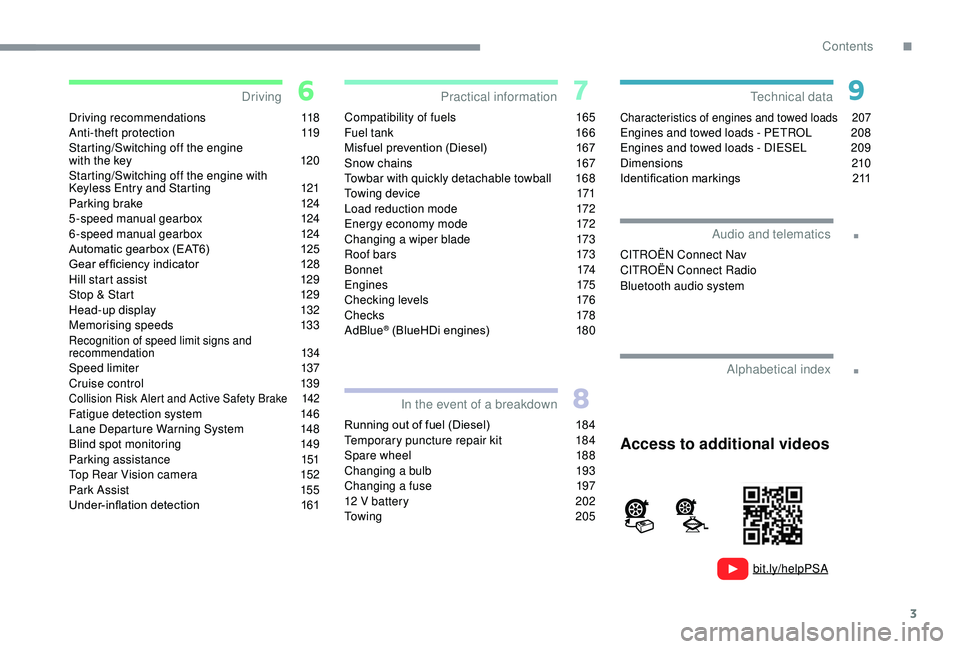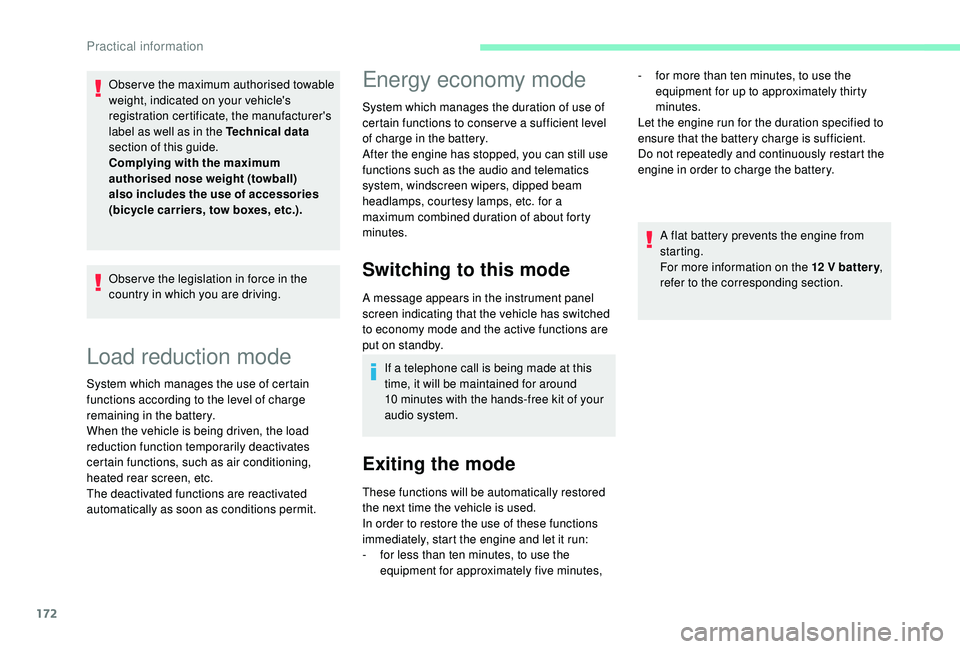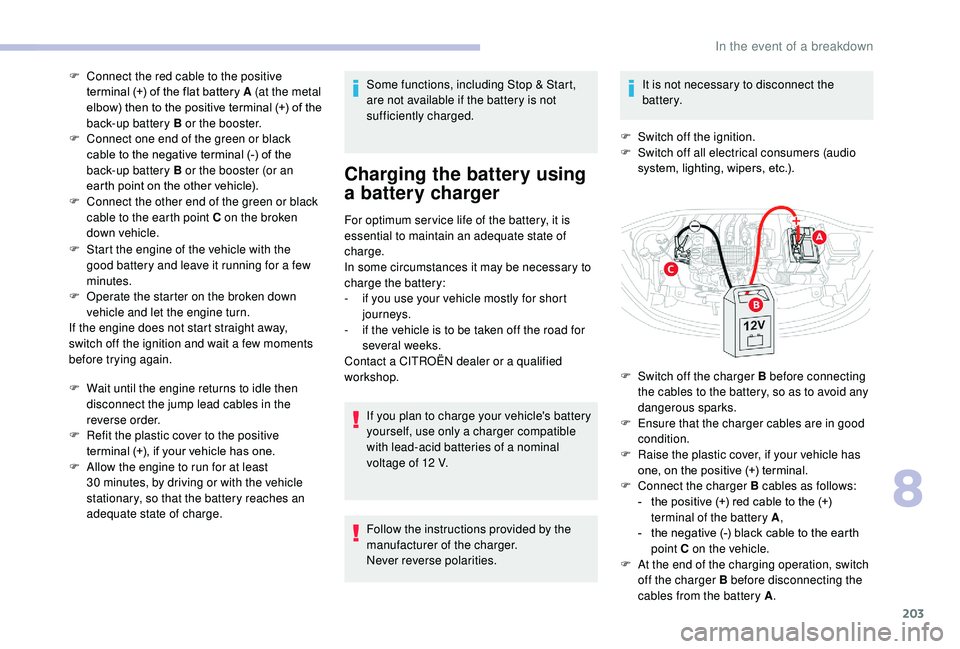run flat CITROEN C3 AIRCROSS 2022 Owners Manual
[x] Cancel search | Manufacturer: CITROEN, Model Year: 2022, Model line: C3 AIRCROSS, Model: CITROEN C3 AIRCROSS 2022Pages: 308, PDF Size: 9.13 MB
Page 5 of 308

3
.
.
bit.ly/helpPSA
Driving recommendations 118
Anti-theft protection 1 19
Starting/Switching off the engine
with the key
1
20
Starting/Switching off the engine with
K
eyless Entry and Starting
1
21
Parking brake
1
24
5-speed manual gearbox
1
24
6-speed manual gearbox
1
24
Automatic gearbox (EAT6)
1
25
Gear ef ficiency indicator
1
28
Hill start assist
1
29
Stop & Start
1
29
Head-up display
1
32
Memorising speeds
1
33
Recognition of speed limit signs and
recommendation 1 34
Speed limiter 137
Cruise control 1 39
Collision Risk Alert and Active Safety Brake 1 42Fatigue detection system 146
Lane Departure Warning System 1 48
Blind spot monitoring
1
49
Parking assistance
1
51
Top Rear Vision camera
1
52
Park Assist
1
55
Under-inflation detection
1
61Compatibility of fuels
1
65
Fuel tank
1
66
Misfuel prevention (Diesel)
1
67
Snow chains
1
67
Towbar with quickly detachable towball
1
68
Towing device
1
71
Load reduction mode
1
72
Energy economy mode
1
72
Changing a wiper blade
1
73
Roof bars
1
73
B o n n e t
174
Engines
175
Checking levels
1
76
C h e c ks
178
AdBlue
® (BlueHDi engines) 1 80
Running out of fuel (Diesel)
1
84
Temporary puncture repair kit
1
84
Spare wheel
1
88
Changing a bulb
1
93
Changing a fuse
1
97
12
V battery
2
02
To w i n g
2 0 5
Characteristics of engines and towed loads 2 07Engines and towed loads - PETROL 208
Engines and towed loads - DIESEL 2 09
Dimensions
210
Identification markings
2
11
DrivingPractical information
In the event of a breakdown Technical data
Alphabetical index
Access to additional videos
Audio and telematics
CITROËN Connect Nav
CITROËN Connect Radio
Bluetooth audio system
.
Contents
Page 130 of 308

128
Malfunction
When the ignition is on, the lighting
of this warning lamp, accompanied
by an audible signal and a message
in the screen, indicates a gearbox
fault.
In this case, the gearbox switches to back-up
mode and is locked in 3
rd gear. You may feel
a substantial knock when changing from P
to R and from N to R. This will not cause any
damage to the gearbox.
Do not exceed 60
mph (100 km/h), local speed
restrictions permitting.
Contact a CITROËN dealer or a qualified
workshop as soon as possible.
There is a risk of damage to the gearbox:
-
i
f you press the accelerator and brake
pedals at the same time,
-
i
f you force the movement of the
selector from position P to another
position when the battery is flat.
To reduce fuel consumption when at
a prolonged standstill with the engine
running (traffic jam, etc.), put the
selector in position N and apply the
parking brake. If your vehicle has an automatic gearbox,
never try to start the engine by pushing
the vehicle.
Gear efficiency indicator
System which reduces fuel consumption by
recommending the most appropriate gear.
Operation
Depending on the driving situation and your
vehicle's equipment, the system may advise
you to skip one (or more) gear(s). You can
follow this instruction without engaging the
intermediate gears.
Gear shift recommendations should not be
considered obligatory. The configuration of the
road, the amount of traffic and safety remain
determining factors when choosing the best
gear. The driver thus remains responsible
for deciding whether to follow or ignore the
system's instructions.
This function cannot be deactivated.
With an automatic gearbox, the system is
only active in manual mode. On BlueHDi Diesel versions with manual
gearbox, in certain driving conditions the
system may suggest changing into neutral so
that the engine can go into standby (STOP
mode of Stop & Start). In this case, N is
displayed in the instrument panel.
Example:
-
Y
ou are in 3
rd g e a r.
-
Y
ou press the accelerator pedal.
-
T
he system may suggest that you engage a
higher gear.
The system adapts its gear change
recommendations according to the
driving conditions (slope, load, etc.)
and the demands of the driver (power,
acceleration, braking, etc.).
The system never suggests:
-
e
ngaging first gear,
-
enga
ging reverse gear,
-
enga
ging a lower gear.
The information appears in the instrument
panel in the form of an arrow.
Driving
Page 174 of 308

172
Load reduction mode
System which manages the use of certain
functions according to the level of charge
remaining in the battery.
When the vehicle is being driven, the load
reduction function temporarily deactivates
certain functions, such as air conditioning,
heated rear screen, etc.
The deactivated functions are reactivated
automatically as soon as conditions permit.
Energy economy mode
System which manages the duration of use of
certain functions to conser ve a sufficient level
of charge in the battery.
After the engine has stopped, you can still use
functions such as the audio and telematics
system, windscreen wipers, dipped beam
headlamps,
courtesy lamps, etc. for a
maximum combined duration of about forty
minutes.
Switching to this mode
A message appears in the instrument panel
screen indicating that the vehicle has switched
to economy mode and the active functions are
put on standby.
If a telephone call is being made at this
time, it will be maintained for around
10
minutes with the hands-free kit of your
audio system.
Exiting the mode
These functions will be automatically restored
the next time the vehicle is used.
In order to restore the use of these functions
immediately, start the engine and let it run:
-
f
or less than ten minutes, to use the
equipment for approximately five minutes, A flat battery prevents the engine from
starting.
For more information on the 12
V batter y
,
refer to the corresponding section.
Obser ve the maximum authorised towable
weight, indicated on your vehicle's
registration certificate, the manufacturer's
label as well as in the Technical data
section of this guide.
Complying with the maximum
authorised nose weight (towball)
also includes the use of accessories
(bicycle carriers, tow boxes, etc.).
Obser ve the legislation in force in the
country in which you are driving. -
f
or more than ten minutes, to use the
equipment for up to approximately thirty
minutes.
Let the engine run for the duration specified to
ensure that the battery charge is sufficient.
Do not repeatedly and continuously restart the
engine in order to charge the battery.
Practical information
Page 186 of 308

184
Running out of fuel
(Diesel)
On vehicles fitted with Diesel engines, the fuel
system must be primed if you run out of fuel.
If the engine does not start first time, do not
keep trying but start the procedure again from
the beginning.For more information on Misfuel
prevention (Diesel) , refer to the
corresponding section.
BlueHDi engines
F Fill the fuel tank with at least five litres of Diesel fuel.
F
S
witch on the ignition (without starting the
engine).
F
W
ait around 6 seconds and switch off the
ignition.
F
R
epeat the operation 10 times.
F
O
perate the starter to run the engine.
Other HDi engines
(Except BlueHDi version)
F
F
ill the fuel tank with at least five litres of
Diesel fuel. F
O
perate the priming pump repeatedly until
resistance is felt (there may be resistance at
the first press).
F
O
perate the starter to start the engine (if the
engine does not start at the first attempt,
wait around 15 seconds before trying
again).
F
I
f the engine does not start after a few
attempts, operate the priming pump again,
then start the engine.
F
P
ut the cover in place and clip it in.
F
C
lose the bonnet.
Temporary puncture
repair kit
Scan the QR code on page 3 to view
explanatory videos.Comprising a compressor and a sealant
cartridge, it allows the temporary repair
of
a tyre so that you can drive to the nearest
garage.
It is designed to repair most punctures which
could affect the tyre, located on the tyre tread
or shoulder.
Only the 12 V socket at the front of
the vehicle allows the compressor to be
connected for long enough to repair or
inflate the vehicle tyre.
The other 12 V sockets of the vehicle
are not designed to be used with the
compressor.
Under-inflation detection
After repair of the tyre, the warning
lamp will remain on until the system is
reinitialised.
For more information on Under-inflation
detection , refer to the corresponding
section.
F
O
pen the bonnet.
F
I
f necessary, unclip the cover to access the
priming pump.
In the event of a breakdown
Page 205 of 308

203
F Connect the red cable to the positive terminal (+) of the flat battery A (at the metal
elbow) then to the positive terminal (+) of the
back-up battery B or the booster.
F
C
onnect one end of the green or black
cable to the negative terminal (-) of the
back-up battery B or the booster (or an
earth point on the other vehicle).
F
C
onnect the other end of the green or black
cable to the earth point C on the broken
down vehicle.
F
S
tart the engine of the vehicle with the
good battery and leave it running for a few
minutes.
F
O
perate the starter on the broken down
vehicle and let the engine turn.
If the engine does not start straight away,
switch off the ignition and wait a few moments
before trying again.
F
W
ait until the engine returns to idle then
disconnect the jump lead cables in the
reverse order.
F
R
efit the plastic cover to the positive
terminal (+), if your vehicle has one.
F
A
llow the engine to run for at least
30
minutes, by driving or with the vehicle
stationary, so that the battery reaches an
adequate state of charge. Some functions, including Stop & Start,
are not available if the battery is not
sufficiently charged.
Charging the battery using
a battery charger
For optimum ser vice life of the battery, it is
essential to maintain an adequate state of
charge.
In some circumstances it may be necessary to
charge the battery:
-
i
f you use your vehicle mostly for short
journeys.
-
i
f the vehicle is to be taken off the road for
several weeks.
Contact a CITROËN dealer or a qualified
workshop.
If you plan to charge your vehicle's battery
yourself, use only a charger compatible
with lead-acid batteries of a nominal
voltage of 12
V.
Follow the instructions provided by the
manufacturer of the charger.
Never reverse polarities. It is not necessary to disconnect the
battery.
F
S
witch off the ignition.
F
S
witch off all electrical consumers (audio
system, lighting, wipers, etc.).
F
S
witch off the charger B before connecting
the cables to the battery, so as to avoid any
dangerous sparks.
F
E
nsure that the charger cables are in good
condition.
F
R
aise the plastic cover, if your vehicle has
one, on the positive (+) terminal.
F
C
onnect the charger B cables as follows:
-
t
he positive (+) red cable to the (+)
terminal of the battery A ,
-
t
he negative (-) black cable to the earth
point C on the vehicle.
F
A
t the end of the charging operation, switch
off the charger B before disconnecting the
cables from the battery A .
8
In the event of a breakdown
Page 296 of 308

216
Replacing the passenger compartment filter ....179Reservoir, screenwash .................................178
Resetting the service indicator .......................28
Resetting the trip recorder
........................3 0 - 31
Reversing camera
...............................
...15 4 -15 5
Roof bars
................................................ 173 -174
Running out of fuel (Diesel)
..........................18 4
SSafety, children .........102-103 , 105 -107 , 111 -115
SCR (Selective Catalytic Reduction) ............18 0
Screen, instrument panel
................................38
Screen, monochrome
...............................32-33
Screen, multifunction (with audio system)
........4
Screen menu map
........................................... 12
Screenwash, front
........................................... 88
Screenwash, rear
............................................ 87
Seat belts
......................................... 9 8 -101, 11 0
Seats, front
...............................
.................57- 5 8
Seats, heated
............................................ 59-60
Seats, rear
................................................. 60-62
Selector, gear
......................................... 125 -128
Serial number, vehicle
..................................2 11
Service indicator
....................................... 26, 28
Servicing
......................................................... 26
S
ettings, equipment
................................... 31- 3 6
Settings, system
........................................ 30, 16
Sidelamps
................................. 80,
82, 193 -195
Side repeater
................................................ 195
Snow chains
................................... 162, 167-168
Socket, 12
V accessory .......................71-72, 76
Socket, auxiliary
...................................... 23,
9, 8
Socket, Jack
............................................ 23, 9, 8
Sockets, audio
................................................ 73
Spe
ed limiter
.......................... 13
3 -13 4, 13 6 -13 9
Speed limit recognition
.......................... 13
4 -13 5
Stability control (ESC)...............................15, 93
Starting a Diesel engine ............................... 16
5
Starting the engine
....................................... 12
0
Starting the vehicle
......... 11
8, 120 -12 2 , 125 -128
Starting using another battery
..............123, 202
Station, radio
...............................
......21-22 , 6, 4
Stay, bonnet
........................................... 174 -175
Steering mounted controls, audio
........ 3,
3, 2-3
Steering wheel, adjustment
............................ 62
S
TOP (warning lamp)
...................................... 12
St
op & Start
..............................
22 , 39 , 66 , 69, 12 9 -131 , 166, 175, 179 , 205
Stopping the vehicle
.......11 8, 120 -12 2 , 125 -128
Storage
...................................................... 71, 75
Storage box
..................................................... 77
Storage wells
.................................................. 77
Stowing rings
.................................................. 75
Sunroof, panoramic
........................................ 53
S
un visor
...............................
..........................71
Switching off the engine
...............................120
Synchronising the remote control
...................47
TTables of fuses ....................................... 1 97-2 01
Ta n k , f u e l ................................................ 166 -167
Telephone
.......... 7
2-73, 25 -29 , 13 -16, 1 0 -11, 13
Telephone, Bluetooth with voice recognition ......14Temperature, coolant ...................................... 25
Three flashes (direction indicators) ................8
2
Time (setting)
........................... 32-33, 40, 31, 17
TMC (Traffic info)
............................................ 13
T
o o l s
........................... 77, 78, 188 -189, 188 -19 0
Total distance recorder
.............................3 0 - 31
Touch screen ....................... 33-36, 86, 13 5 , 1, 1
To w b a r
...............................
....................11 9, 171
Towbar with quickly detachable towball ...... 1 6 8 -171
Towed loads .................................................. 207
Towing another vehicle .........................205-206
Traction control (ASR)
...................15 -16, 93-95
Traffic information (TA)
.....................................5
Traffic information (TMC)
................................13
Tr a i l e r
...............
..................................... 11 9, 171
Trip computer
............................................. 37- 3 9
Trip distance recorder
............................... 3
0 - 31
Ty r e s
.............................................................. 2 11
Tyre under-inflation detection
.........15, 161 , 188
UUnder-inflation (detection) ............................161
Unlocking .................................................. 42- 43
Unlocking from the inside
...............................49
Updating the date
................................ 40,
31, 18
Updating the time
...............................
.40 , 31 , 17
USB
................................................... 23 -24, 9, 7
VVentilation ................................................. 64- 67
Voice commands ......................................... 5 -10
WWarning and indicator lamps .....................1 0 -11
Warning lamp, braking system .......................12
Warning lamp, Diesel engine pre-heater
.......21
Warning lamp, driver’s seat belt not fastened
...............................
....9 9 -10 0
Warning lamp, low fuel level
...........................17
Warning lamp, seat belts
........................9 9 -10 0
Warning lamp, Service ....................................20
Alphabetical index